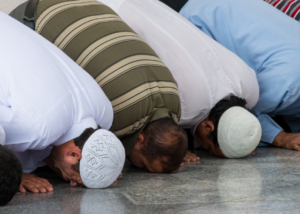How does a Hanafi pray Sajdah Sahw (Forgetfulness Prostration)? Can you clarify the Hanafi correct position regarding this?
Quran
Hadith
Islamic Text
بِسْمِ اللَّهِ الرَّحْمَنِ الرَّحِيمِ
In the Name of Allah Most Merciful Most Kind
Short Answer
Hanafi scholars stated that Sajdah Sahw (Forgetfulness Postration) is performed after one Salaam and thereafter reciting Tashahud again. The complete method is described later on. However, this is only one of the most important rulings of the prayer.
Explanation
There are different Hadith narrations with regards to the Sajdah Sahw. Some of them mention performing it after one Salaam and then repeating the Tashahud, and others have it at the end.
However, Hanafi scholars were more convinced of the Hadith narrations that spoke about performing Sajdah Sahw after one Salaam and reciting the Tashahud again:
وَإِذَا شَكَّ أَحَدُكُمْ فِي صَلَاتِهِ فَلْيَتَحَرَّ الصَّوَابَ فَلْيُتِمَّ عَلَيْهِ ثُمَّ لِيُسَلِّمْ ثُمَّ يَسْجُدُ سَجْدَتَيْنِ
The Prophet ﷺ said, ‘If one of you doubts in prayer let him estimate and complete (his prayer), then make Salaam and then make two prostrations.’ (Sahih al-Bukhari, 401).
As such, a Hanafi would pray Sajdah Sahw as follows:
- Recite Tashahud in the final sitting.
- Make one Salaam to the right.
- Perform two prostrations of forgetfulness.
- Recite the Tashahud again from the beginning then complete the prayer as normal.
Consequently, the methodology in the Hanafi Madhab is that you would recite Attahiyat to “Abduhu Wa Rasooluh” and make one Salaam to the right. Next, you perform the two Sajdah of Sahw (prostrations of forgetfulness). Afterwards, recite the Attahiyat again, followed by Durood Sharif and Dua. Finally, you make the two Salaams to end the prayer.
There are some slightly variant options within the Hanafi Madhab but this is probably the clearest and easiest.
Classical Scholars
Regarding the Hanafi position on praying Sajdah Sahw, Imam Abdullah bin Mahmood al-Mowsili said in al-Ikhtiyaar:
قَالَ: (وَيَسْجُدُ لَهُ بَعْدَ السَّلَامِ سَجْدَتَيْنِ ثُمَّ يَتَشَهَّدُ وَيُسَلِّمُ) قَالَ – عَلَيْهِ الصَّلَاةُ وَالسَّلَامُ -: «لِكُلِّ سَهْوٍ سَجْدَتَانِ بَعْدَ السَّلَامِ». وَرَوَى عِمْرَانُ بْنُ حُصَيْنٍ وَجَمَاعَةٌ مِنَ الصَّحَابَةِ: «أَنَّهُ – صَلَّى اللَّهُ عَلَيْهِ وَسَلَّمَ – سَجَدَ سَجْدَتَيِ السَّهْوِ بَعْدَ السَّلَامِ»، ثُمَّ قِيلَ يُسَلِّمُ تَسْلِيمَتَيْنِ، وَقِيلَ تَسْلِيمَةً وَاحِدَةً وَهُوَ الْأَحْسَنُ، ثُمَّ يُكَبِّرُ وَيَخِرُّ سَاجِدًا وَيُسَبِّحُ، ثُمَّ يَرْفَعُ رَأْسَهُ، وَيَفْعَلُ ذَلِكَ ثَانِيًا، ثُمَّ يَتَشَهَّدُ وَيَأْتِي بِالدُّعَاءِ ; لِأَنَّ مَوْضِعَ الدُّعَاءِ آخِرُ الصَّلَاةِ، وَهَذَا آخِرُهَا.
He said “and he prostrates twice for it after Salam then he recites the Tashahud and makes Salaam.” The Prophet ﷺ said, “for every forgetfulness are two prostrations after Salam.” And it is narrated by Imran Ibn Hussain and a group of the companions that he Prophet ﷺ prostrated two prostrations of forgetfulness after the Salaam. It is said that he makes two Salaams and it is also mentioned that he makes one Salam, and this is the more correct opinion.
Then he says “Allahu Akbar” and falls in prostration and glorifies (Tasbeeh). Then raises his head and does this for a second time. Then recites Tashahud and a Dua because the place of Dua is at the end of the prayer and this is its end.
And Allah Most High Knows Best.
–Answered by Shaykh Noorud-deen Rashid (04.01.21)






